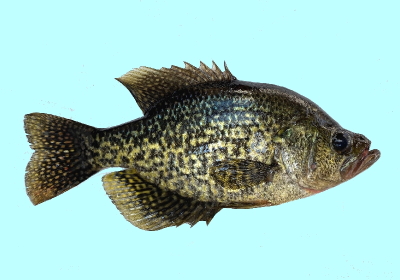|
|
Black Crappie fish, its habitats, characteristics, fishing methods.
Crappie belongs to the sunfish family, they are very sensitive to sunlight. They feed mostly at dawn, dusk and at night all year round, but feed less often when water temps dips below 50 degrees when their metabolism is slower. They eat small fish, mollusks, insects, minnows and crustaceans, they also feed on gizzard and threadfin shad. Crappie are fish that love structures, so concentrate on cover such as brush piles, stumps, fallen trees, rock piles, humps, or any other submerged cover. Crappie are pretty active all year round, but spring and fall are the hottest times to catch them.
A combination of understanding the fish and the techniques used to catch them will help you to hook more fish to the end of your line. Better knowing and understanding of the fish that you are trying to catch will make you a more successful angler, whether you are fishing for trout on a river or surfing on the beach or trolling on the open water.

|
Black Crappie – Pomoxis nigromaculatus, also known as speckled perch, specks, papermouth, bachelor perch, calico bass, strawberry bass, or white perch, members of
Sunfish and the
Black bass family. They reach up into southern Manitoba, Ontario and Quebec in Canada. It is only noticeably scarce in a swathe of the Midwest stretching from western Texas up through Nevada, Colorado, Utah, Wyoming, Idaho, and western Montana.
|
Description
The black crappie is darker, has 7 or 8 dorsal spines, and has spotted sides. The spots are irregular and scattered. Black crappie grows to over 5 lbs while ¾ to 1lb is more typical. They average 6-11inches fully grown, however with enough food and cover they can reach lengths up to 17 inches.
Habitats
The black crappies live in large ponds and shallow area of
lakes, with sandy or mud-covered bottoms and usually in areas of rich vegetation. It requires a deeper, clearer, rather cooler habitat that does the white crappie. It is a plentiful species and is challenging sport fish.
Spawning
When the water hits about 48-51 degrees just before spawning, they move into shallower water and feed aggressively. Crappie move into shoreline cover such as fallen trees and shallow coves during this pre-spawn period. The females will then lay their eggs and move to slightly deeper water while the males stay in the shallows and guard the nest. If you catch several smaller fish in shallow water, try moving to the nearest drop-off and you may find the larger females feeding. These pre-spawn and spawn periods of spring often offer the best fishing of the year.
Fishing Methods.
Crappie is school fish and can be caught by still-fishing, casting, trolling or drifting.
Pole Fishing using very light, flexiple
Carbon Pole rod is the most popular method. Spring is the best time to catch crappie as they are involved in their spawning runs. They love cover, so locate brush, stumps or artificial cover at appropriate depths and you are likely to find crappie. At dawn you may find them close to the surface. As the sun hits the water they drop to 5 or 10 feet deep depending on water clarity. As the sun gets higher in the sky they may move back to deeper water, 25 feet or more. As the sun begins to set they will move back up to the shallows and finish the day at the surface as dusk turns to darkness. Typically they return to deeper water for the night and may occasionally do some feeding during the dark hours.
The cooling water of the fall also offers good crappie fishing. When the warm summer waters begin to cool down, the fish begin feeding aggressively in order to fatten up for the winter. Schools of big slabs can be caught easily during this "fall feed-up". Crappie are fish that love structure, so look in at the areas with prominent cover. Rock piles, shallow coves, stumps, points, fallen trees, and submerged brush are all favorites.
Bait fishing with live minnow are probably one of the best. Vertical jigging is a good method to fish sunken cover or brushes. Swim a small spinner through stump fields or along fallen trees to locate the slabs. When you identify the depth at which most of the fish are holding, try to suspend a jig or minnow at that depth under a small float. This will keep your bait in the particular depth for a long period of time until fish will see it. Baits which look like crayfish and minnows, insects, worms or small crustaceans will attract crappie. The more aggressive the crappies are, the faster you can move the bait to cover more water and as a result to get more fish.
In clear and lightly stained waters, the most important is to match the natural food items. When fishing with a minnow type lure, try to use natural looking colors such as smoke, silver or gray. When jigging near or on the bottom, try using dark brown or dark green lures.
In stained or mud-covered waters, the good way to attracting strikes is vibration that can help crappie to find food in dark water and brightness. Dark water filters out most of the sunlight, often the fish can see much better with lighter penetrating. Spinners, grubs, and jigs that are kept moving are usually good choices. The best fishing is during mid-day or bright sunlight times using bright colors of the spinners.
On cloudy, gloomy days not much sunlight reaches the fish. Better to use browns, greens, and even black spinners to fish on cloudy days. On sunny days the brightest lure is the color you try first. The silver or gold spinners can produce extra flash that can attract fish. At night try to jet black lures, or combinations of black and other dark colors.
|
|
|

